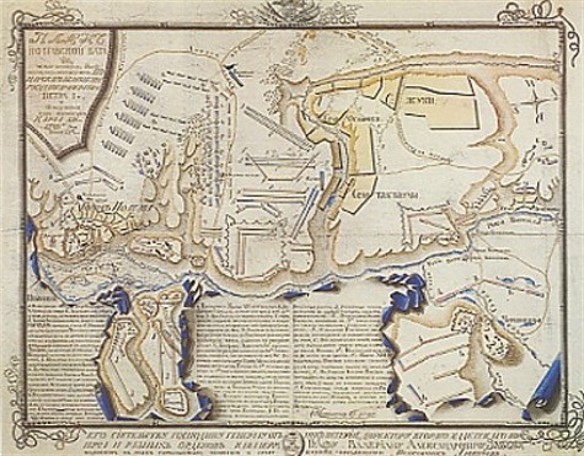Poltava, Battle of
Poltava, Battle of. The turning point in the Great Northern War (1700–21) between Sweden and Muscovy (later Russia). When Hetman Ivan Mazepa learned that Tsar Peter I intended to abolish the autonomy of the Hetman state, he began secret negotiations with Charles XII of Sweden to ensure that Ukraine would not be annexed by Poland in the event of a Swedish victory. After the main Swedish army entered Ukraine, Mazepa openly sided with Charles against Peter. The entire matter was complicated by the fact that the Swedish force that was to have marched directly on Moscow had unexpectedly turned south toward Ukraine before reaching Smolensk. Mazepa was left in an awkward position, but tried to accommodate the Swedes as well as he could.
Because of the harsh winter of 1708–9 and a series of military defeats the situation of the Swedish army in Ukraine became precarious. The assistance Charles XII expected from Turkey and the Crimean Khanate did not materialize, and the Polish army of King Stanislaus I Leszczyński and a Swedish corps were forced to remain in Poland to fight the supporters of Frederick Augustus II. Charles’s only success at that time was enlisting the support of Otaman Kost Hordiienko and his army of 8,000 Zaporozhian Cossacks in April 1709. Semiencircled by the Muscovites, Charles chose not to retreat to Volhynia (as his generals counseled) but to advance to the Vorskla River and thence on to Moscow via Kharkiv and Kursk. Several fortified cities on the way encumbered Charles’s advance. One such city was Poltava, situated at the intersection of important routes to Southern Ukraine, Right-Bank Ukraine, and Slobidska Ukraine and the Don region. It was defended by a garrison of 4,300 Muscovite soldiers and 2,600 Ukrainian volunteers commanded by Gen Aleksei Kelin.
In early May 1709, on Ivan Mazepa’s advice, Charles XII decided to capture Poltava. Having failed to take it by storm, he besieged and bombarded the hungry city. Peter I arrived to relieve Poltava and decided his army of 42,500 soldiers and 102 cannons would attack the Swedes on 10 July. Cossack forces loyal to Peter under the command of Hetman Ivan Skoropadsky cut off possible Swedish retreat to the Dnipro River between Pereiaslav and Kremenchuk. Charles had 31,000 men but only 4 cannons; 6,000 of his soldiers were engaged in maintaining the siege or guarding the Vorskla River rear. Mazepa’s small force was held in reserve to protect the Swedish western flank and ensure that Kelin would not attack from the fortress.
When Charles XII learned, during the night of 7 July, that a Kalmyk army of 40,000 would arrive to reinforce the Muscovites in two days, he decided to act first and destroy the Muscovite encampment in a lightning blow. At 5 AM on 8 July the Swedish infantry advanced on Muscovite positions but was repelled by cavalry. The Swedish cavalry successfully engaged its counterpart but was forced to retreat under heavy fire. The Swedish infantry attacked once more and captured two Muscovite redoubts, but failed to hold them. As the Swedes attempted to bypass the redoubts, Prince Aleksandr Menshikov’s troops encircled them and inflicted heavy casualties. Fifty to seventy meters from Muscovite positions the Swedes met a hail of deadly artillery fire. Panic ensued in their ranks, but they managed to retreat into the nearby Budyshcha forest, where Charles was able, with considerable difficulty, to restore order.
At around 9 AM, having regrouped their forces, both Peter I and Charles XII ordered their troops to advance. Intense Muscovite artillery fire again created chaos in the Swedish ranks, their center buckled, and a disorderly retreat ensued to the Swedish encampment, which by then had been captured by Muscovite forces. By 11 AM the Swedes had been routed. Over 9,300 died, and nearly 2,900 were taken prisoner, including Field Marshal C.-G. Rehnskjold and the first minister, C. Piper. The Muscovite army suffered 1,345 dead and 3,290 wounded. Swedish units that were not captured were led by Gen A.L. Lewenhaupt along the Vorskla River to Perevolochna, whence Charles, Ivan Mazepa, and Kost Hordiienko and a contingent of 3,000 Swedes and Cossacks crossed the Dnipro River and fled into Turkish-occupied territory. A.L. Lewenhaupt’s army of 16,000 was forced to capitulate and surrender to Menshikov. According to the fifth provision of the capitulation agreement Cossacks under Swedish command were handed over to the Muscovites. Most of them were executed on the spot, and the rest were exiled to Siberia.
The Battle of Poltava resulted in Russian military rule in the Hetman state and increasing curtailment of its autonomy. The Museum of the History of the Battle of Poltava, which very much lauded Peter’s triumph, was opened at the battle site in 1950.
BIBLIOGRAPHY
Adlerfelt, G. The Military History of Charles XII, King of Sweden, Written by the Express Order of His Majesty, 3 vols (London 1740)
Iunakov, N. ‘Severnaia voina: Kampaniia 1708–1709 gg.,’ Trudy Imperatorskago Russkago voenno-istoricheskago obshchestva, vols 2 and 4 (Saint Petersburg 1909)
Beskrovnyi, L.; et al (eds). Poltava: K 250-letiiu Poltavskogo srazheniia: Sbornik statei (Moscow 1959)
Diadychenko, V. (ed). 250 rokiv Poltavs'koï bytvy (1709–1959): Zbirnyk statei (Kyiv 1959)
Grekov, M.; Koroliuk, V. (eds). Poltavskaia pobeda: Iz istorii mezhdunarodnykh otnoshenii nakanune i posle Poltavy (Moscow 1959)
Serczyk, W. Połtawa 1709 (Warsaw 1982)
Englund, P. The Battle of Poltava: The Birth of the Russian Empire (London 1992)
From, P. Katastrofen vid Poltava : Karl XII:s ryska fälttåg 1707–1709 (Lund 2007)
Theodore Mackiw
[This article was updated in 2008.]

.jpg)
